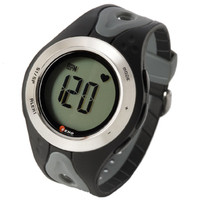 22nd Jun 2015
22nd Jun 2015
Heart Rate Monitors for Athletes
I remember when I started working out at the gym 20 years ago (yikes), I started on the elliptical which had a heart rate monitor function that I used sporadically. My goal was fat-burning so I aimed to keep my heart rate in the fat-burning zone according to their monitor. Little did I know that squeezing those sensors and seeing my heart rate change according to how hard I worked would begin my affair with working out.
Look, working out is about results. Yes, we may do it because we like a particular sport or activity, but ultimately we do it because we like the results (and endorphins, love those endorphins). And a workout is only as effective as the intensity or quality of our work doing our activity of choice, which is where the heart rate monitor comes in.
A heart rate monitor (HRM) is a device used to find your target zone of heart beats per minute. Think of your heart rate monitor as your pacer, telling you when to speed up or slow down depending on the results you’re working towards.
Heart Rate Monitor for Athletes Including Runners, Swimmers, and Endurance Sport Athletes
Now as with any bit of technology, you have a few choices as to how you wear your monitor. So, let’s look at our heart rate monitor choices.
Chest strap model: I used one of these bad boys for each (okay, 3) of the triathlons I trained for. In this monitor, a wireless sensor on the chest strap detects your pulse electronically and sends the data to a wristwatch-style receiver. In the basic models, you can time your workout and get continuous average, high and low heart rate data. In some advanced models, they even submit a signal so other HRM’s don’t interfere with your data.
What’s sassy about this model is it can be paired with a foot pod attached to your shoelace that then captures data about speed, distance and cadence. Some even have GPS capabilities to track speed distance and elevation. Seriously, I could geek out over all the data you can collect.
Strapless model: With the strapless model, the heart rate sensor is built into the watch’s wristband or case back. These models now interface with software in order to guide, analyze and create your training program.
Who Should Use Heart Rate Monitors
Heart rate monitors aren’t just for athletes, yo. I mean I’ve used them! They are useful for a lot of folks, so let me breakdown some specific groups heart rate monitors are useful for:
Injury-rehabilitation patients: Real-time feedback is invaluable when treating patients recovering from injury, illness, including cardiac incidents. The feedback helps ensure a gradual build towards full strength and endurance.
Weight-loss folks: HRM’s are a great tool towards evaluating the effectiveness of new and existing exercise regimens by displaying calories burned and helping target the heart rate zone for maximum fat burning.
Joggers and Walkers: So you don’t have to be an elite athlete to benefit from a heart rate monitor. HRM’s will pinpoint fat-burning and aerobic zones so you can get the most out of your exercise time.
Runners: Heart rate monitors will keep you in your peak target zone on training days and at your aerobic base on easy run days.
Cyclists: By cyclist, I mean whether you bike on a trail, road, or stationary trainer. An HRM can track your performance during interval or endurance rides.
Hikers, climbers and skiers: HRM’s can help condition more effectively for high altitudes and the endurance needed to get there.
So, if you’re starting to feel like I’m saying heart rate monitors are for everyone, you’re right. If you are starting to exercise, exercise currently or compete athletically, heart rate monitors are an awesome tool for tracking your progress in gaining strength, endurance and reaching training goals. I can’t tell you how addicting and satisfying it is to see you hit your target heart rate zone and begin surpassing training goals you’ve set for yourself. It really does a girl (and guy) good.








